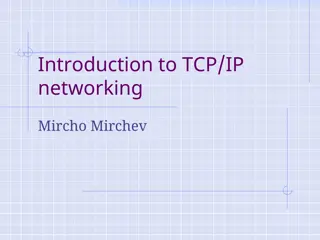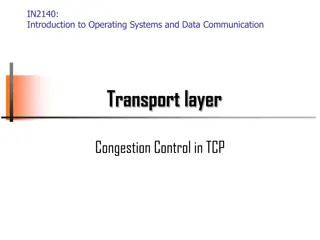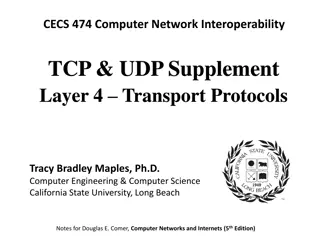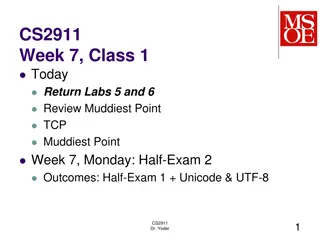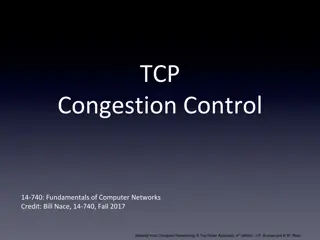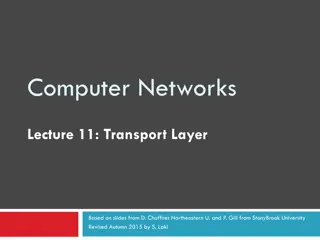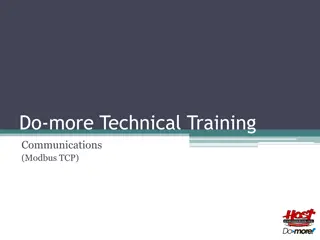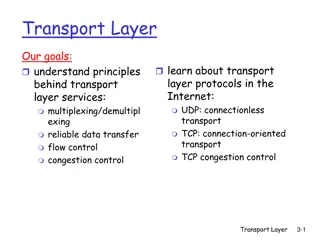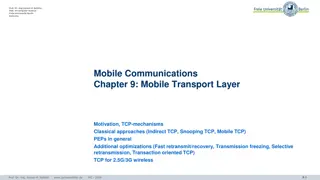TCP Congestion Control Mechanisms
Delve into the world of TCP congestion control through advanced concepts such as slow start, congestion avoidance, feedback mechanisms, and various TCP variations like New Reno and Vegas. Explore the intricate algorithms and behaviors that govern network throughput and delay management.
Uploaded on Nov 17, 2024 | 2 Views
Download Presentation

Please find below an Image/Link to download the presentation.
The content on the website is provided AS IS for your information and personal use only. It may not be sold, licensed, or shared on other websites without obtaining consent from the author.If you encounter any issues during the download, it is possible that the publisher has removed the file from their server.
You are allowed to download the files provided on this website for personal or commercial use, subject to the condition that they are used lawfully. All files are the property of their respective owners.
The content on the website is provided AS IS for your information and personal use only. It may not be sold, licensed, or shared on other websites without obtaining consent from the author.
E N D
Presentation Transcript
Advanced Congestion Control (Hosts) 14-740: Fundamentals of Computer Networks Credit: Bill Nace Material from Computer Networking: A Top Down Approach, 5thedition. J.F. Kurose and K.W. Ross
Congestion Control (2) Apply some control theory Region 1: Low throughput Region 2: High delay Throughput increases slowly Delay increases quickly Region 3: Collapse Throughput 0, Delay At what load would we like to operate?
Feedback Mechanism End-to-end: Messages from receiver Network Assisted: Signals from routers 14-740: Spring 2018 3
Slow Start When connection begins, increase rate exponentially: double CongWin every RTT done by incrementing CongWin for every ACK received Summary: initial rate is slow but ramps up exponentially fast
Congestion Avoidance Additive Increase: Increase CongWin by 1 MSS every RTT until loss is detected Multiplicative Decrease: cut CongWin in half after a loss event Sawtooth behavior: Probing for bandwidth 14-740: Spring 2018 5
TCP CC States CongWin ssthresh Slow start Cong Avoid timeout ACK 3dupACK 3dupACK Fast Recovery
traceroute Advanced TCP Congestion Control Lots of algorithmic variants Long Fat Networks problem TCP-BIC Compound TCP Prisoner s Dilemma 14-740: Spring 2018 7
TCP Variations TCP New Reno TCP Vegas TCP Hybla BIC / CUBIC Compound TCP many others exist (SACK, Veno, Westwood, XCP, YeAH-TCP, . . .) 14-740: Spring 2018 8
TCP New Reno Improves fast recovery retransmissions RFC 2582 & 3782 Good at filling multiple holes, but still probing for higher throughput Substantially outperforms Reno at high error rates 14-740: Spring 2018 9
New Reno: Improve Fast Recovery In Fast Recovery: Record highest unACKed# already sent Return to cong-avoid when this segment is ACKed For each Dup ACK, new segment sent keeps transmit window full For each good ACK -- hole assumed retransmit segment just past the ACK seqnum 14-740: Spring 2018 10
TCP Vegas First delay-based TCP variant Look for variations in RTT as indication of queue length at routers (i.e. oncoming congestion) If lower than expected RTT, send more If higher, send less (by lowering CongWin) Congestion prevention strategy 14-740: Spring 2018 11
TCP Vegas (2) Goal: keep a certain amount of data in the queues of the network Much smoother flow than Reno Achieves higher average throughput But, when competing with Reno, only gets ~2/3 of Reno's bandwidth Backs off before congestion, while Reno backs off only after congestion Source: Brakmo94 and La99. Available on course website 14-740: Spring 2018 12
TCP Hybla Goal: improve high-latency / high-error rate links (i.e. satellite) Much longer RTT Segments dropped due to bit-error look like congestion Analytically evaluates CongWin dynamics Rather than measuring RTT Included in Linux from 2.6.13 Source: Caini2004. Available on course website 14-740: Spring 2018 13
The LFN Problem Long Fat Networks: High-speed and high- latency Many, many segments will be in-flight How many? Bandwidth-Delay Product 14-740: Spring 2018 15
The LFN Problem How many? Ex: 10Gbps, 100ms RTT, MSS 1500B CongWin = 83,333 segments Needs loss event < every 1hr 40 min Else never gets out of Slow Start i.e. 1 event per 5 billion segments Bit Error Rate of 2x10-14 unrealistic Example from RFC3649 written in Dec 2003 14-740: Spring 2018 16
LFN Approaches Get lots of segments in flight: Start really quickly Can we do better than Slow Start? Be more aggressive in CongAvoid AIMD approach of adding 1 won t cut it 14-740: Spring 2018 17
Binary Increase Congestion TCP-BIC uses a binary search to probe for additional bandwidth Default for Linux 2.6.8-2.6.18 Replaced with Cubic, a fairer alternative 14-740: Spring 2018 18
Binary Search Target CongWin is halfway between max and min, 2 control variables If CongWin grows to target, set min to current, recalculate target If loss happens, set max to current, min to recovery point, recalculate target
BIC: Fairness An overly aggressive algorithm will rob bandwidth from normal TCP algorithms BIC incorporates fairness idea Binary search means less aggressive when near bandwidth maximums Also includes a plateau period to allow TCP flows to get out of slow start 14-740: Spring 2018 20
What is Congestion? Loss-based: Look for 3 dup ACK, timeout Used in Reno, HSTCP, STCP, TCP-BIC Delay-based: Look for variations in RTT, estimate queue lengths at routers Used in TCP Vegas, FAST TCP 14-740: Spring 2018 21
Compound TCP A hybrid of loss-based and delay-based algorithms More aggressively seeks for additional bandwidth when no evidence of congestion Attempts to be especially fair to other protocols Used since Microsoft Vista 14-740: Spring 2018 22
CTCP Mechanisms Key idea is to use a normal congestion window, combined with a delay-based congestion window TotalCongWind = cwind + dwind cwind updated normally (AIMD) in CongAvoid No loss cwind = cwind + 1MSS per RTT* Loss (timeout, 3 dup ACK) cwind = cwind / 2 *Actually, a small adjustment as TotalCongWind should grow by 1MSS per RTT 14-740: Spring 2018 23
Delay Window If network bandwidth is underutilized (based on RTT observations) dwind(t+1) = dwind(t) + dwind(t)k If some queueing happening dwind(t+1) = dwind(t)-queue length* If there is a loss dwind(t+1) = (1 - ) dwind(t) , , k are tuning parameters for scalability, smoothness and responsiveness *Yes, there s a complicated way of predicting what the queue lengths might be. Let s skip it... 14-740: Spring 2018 24
Fairness TCP flows compete for additional bandwidth If one flow is too aggressive, it will cause segment loss in other flows (and perhaps itself) Segment loss will cause other flows to retreat Which may provide additional bandwidth to the aggressor Especially problematic with delay-based Sense congestion earlier than a loss 14-740: Spring 2018 25
CTCP Fairness When no congestion sensed, full-speed ahead! When congestion first sensed (via delay measurements) stop seeking more BW When loss occurs, back off normally 14-740: Spring 2018 26
traceroute Advanced TCP Congestion Control Lots of algorithmic variants Long Fat Networks problem TCP-BIC Compound TCP Prisoner s Dilemma 14-740: Spring 2018 27
Prisoners Dilemma Game-theory problem with interesting implications for networks Classic Form 2 conspirators arrested Separately offered a deal Each must choose to betray or remain silent B stays silent 6 months each A: 10 years B betrays A silent B: Goes free 5 years each A: Goes free B: 10 years A betrays
Why Discuss? TCP restrictions are self-imposed Nothing in the network checks that sender is actually following the algorithms Bad behavior can have short-term advantages Examples?
Silly Window Syndrome A serious problem can arise in the sliding window operation when the sending application program creates data slowly, the receiving application program consumes data slowly, or both. If a server with this problem is unable to process all incoming data, it requests that its clients reduce the amount of data they send at a time (the window setting on a TCP packet). If the server continues to be unable to process all incoming data, the window becomes smaller and smaller, sometimes to the point that the data transmitted is smaller than the packet header, making data transmission extremely inefficient. The name of this problem is due to the window size shrinking to a "silly" value. Since there is a certain amount of overhead associated with processing each packet, the increased number of packets means increased overhead to process a decreasing amount of data. The end result is thrashing. -- https://en.wikipedia.org/wiki/Silly_window_syndrome 14-740: Spring 2018 30
Silly Window Syndrome There are 3 causes of SWS: When the server announces empty space as 0 When client is able to generate only 1 byte at a time When server is able to consume only 1 byte at a time During SWS, efficiency of communication is almost 0, so SWS duration should be short as possible -- https://en.wikipedia.org/wiki/Silly_window_syndrome 14-740: Spring 2018
Silly Window Syndrome When there is no synchronization between the sender and receiver regarding capacity of the flow of data or the size of the packet, the window syndrome problem is created. When the silly window syndrome is created by the sender, Nagle's algorithm is used. Nagle's solution requires that the sender send the first segment even if it is a small one, then that it wait until an ACK is received or a maximum sized segment (MSS) is accumulated. When the silly window syndrome is created by the receiver, David D Clark's solution is used. Clark's solution closes the window until another segment of maximum segment size (MSS) can be received or the buffer is half empty. -- https://en.wikipedia.org/wiki/Silly_window_syndrome 14-740: Spring 2018
Nagles Algorithm Interacts badly with TCP delayed acknowledgments. With both algorithms enabled, applications that do two successive writes to a TCP connection, followed by a read that will not be fulfilled until after the data from the second write has reached the destination, experience a constant delay of up to 500 milliseconds, the "ACK delay". For this reason, TCP implementations usually provide applications with an interface to disable the Nagle algorithm. This is typically called the TCP_NODELAY option. A solution recommended by Nagle is to avoid the algorithm sending premature packets by buffering up application writes and then flushing the buffer. The user-level solution is to avoid write-write-read sequences on sockets. write-read-write- read is fine. write-write-write is fine. But write-write-read is a killer. So, if you can, buffer up your little writes to TCP and send them all at once. Using the standard UNIX I/O package and flushing write before each read usually works. -- https://en.wikipedia.org/wiki/Nagle%27s_algorithm 14-740: Spring 2018
Lesson Objectives Now, you should be able to: describe features of the following TCP congestion control variations: New Reno, Vegas, Hybla, BIC and Compound TCP describe the advantages and disadvantages of delay-based variants 14-740: Spring 2018 34
You should be able to: describe the challenges of congestion control for LFNs describe the problems and attractions of a non-cooperative TCP implementation Describe Silly Window Syndrome and how TCP addresses it.
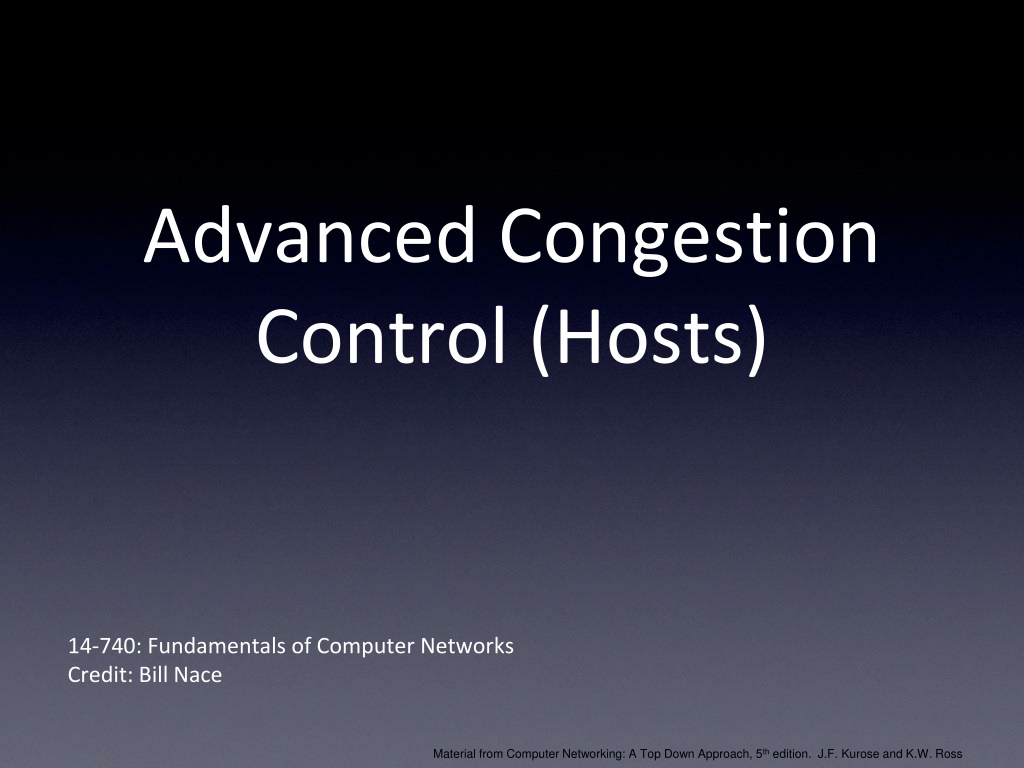
 undefined
undefined
 undefined
undefined




